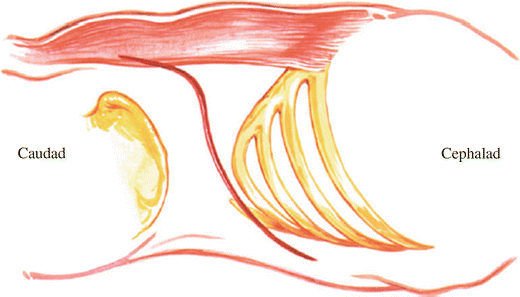(1)
Marina Spine Center, Marina del Rey, CA, USA
The 12th rib resection with flank incision was developed to allow better exposure of the kidney (Fig. 22.1) [1 – 3]. The 12th rib and its periosteal bed are joined at the rib’s tip by the insertion of the diaphragm and of the transversus abdominis fascia and muscle. They form an anchoring point to resist cephalad retraction. By removing the 12th rib, opening the 12th rib bed, and freeing the muscle insertions of the tip of the 12th rib, one has greater exposure for cephalad retraction when exposing the kidney, retroperitoneal space, or spine. Resection of the rib and the periosteum of the rib bed allows release of the posterior lumbocostal ligament, which is a strong tether against cephalad retraction, and frees the fibers of the internal/external oblique muscles. With the added exposure, the L1 vertebral body and distal segments can be adequately visualized.


Fig. 22.1
Incise the skin and subcutaneous tissue from the costotransverse junction to 6 inches anterior to the tip of the 12th rib. Resect the 12th rib with a standard thoracotomy technique, and extend the anterior incision to open the abdominal musculature as described in Chapter 18. The chief advantage of the 12th rib excision is that it allows easier retraction and exposure of the upper lumbar spine. Removal of the rib and preservation of the rib bed does not add greatly to ease of retraction; therefore, the rib bed should be opened as in a standard thoracotomy technique except extrapleurally, as described in Chapter 19. The approach is an extrapleural approach; therefore, identification of the peripheral extent of the pleura should follow Digby’s rules. 1. Study the maximum inspiration chest X-ray taken before the operation to show the lower extent of the pleura. 2. Exposing the periosteum on the outer side of the rib before incising it avoids deep plunges that can section the pleura off the rib surface. 3. Avoid sharp projecting fragments on the stump of the last rib and cover the stump with a tethered gauze roll. 4. Make the longitudinal incision in the periosteum and inner aspects of the last rib sufficiently far out to be below and beyond the pleura reflection
One of the major complications of the thoracolumbar approach is damage to the pleura in the region of the 12th rib. The relationship of the pleura to the 12th rib, as presented by Myney and Hughes,1 begins with a classification of 12th ribs into a long type of 11–14 cm and a short type of 1.5–6 cm. In the more common long rib the pleura are usually on the undersurface of the posterior 6 cm of the rib. The pleura may extend over the T11–T12 interspace anteriorly as far as 10–11 cm from the midline. With short 12th ribs, the entire length of the rib should be considered to be covered with pleura (see Figs. 18.1, 20.3, 22.2). With this location of the pleura in mind, one may follow the four steps outlined by Digby for avoiding the pleura:


Fig. 22.2
The rib bed of the 12th rib and its relationship to the pleura. This rib bed must be opened while maintaining an extrapleural position. With a long 12th rib the pleura usually only extends medially as far as the lateral three-fourths of the rib bed. Therefore, it is easier to begin the plane of dissection at the medial tip of the rib bed, progress laterally, find the pleura, and dissect it off. With a short (6-inch or smaller) 12th rib, dissection at the tip of the rib must be done as carefully as described in Chapter 19 because pleura covers the entire rib
1.
Study the maximum inspiration chest X-ray taken before the operation to show the lower extent of the pleura.
2.
Expose the periosteum on the outer side of the rib before incising it to avoid deep plunges that can section the pleura off the rib surface.
3.




Avoid sharp projecting fragments on the stump of the last rib and cover the stump with a tethered gauze roll.
Stay updated, free articles. Join our Telegram channel

Full access? Get Clinical Tree








